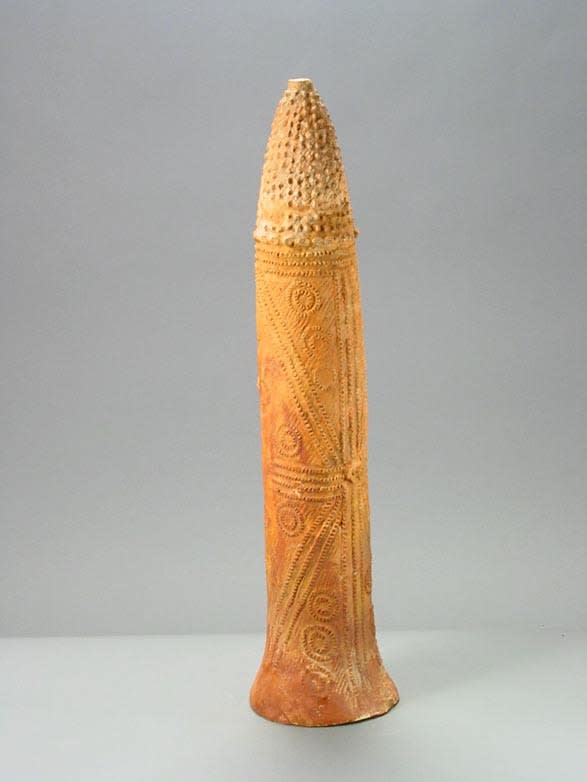Bura Terrracotta Phallic Vessel, 3rd Century CE - 11th Century CE
Terracotta
X.1042 (LSO)
Further images
This highly intricate and unusually-formed terracotta phallomorphic figure was sculpted by one of the most inscrutable groups in pre-colonial Africa: the Bura. Like many other pieces, it is proportioned in...
This highly intricate and unusually-formed terracotta phallomorphic figure was sculpted by one of the most inscrutable groups in pre-colonial Africa: the Bura. Like many other pieces, it is proportioned in the general manner of a phallus, with different sections decorated in different way. What would be the circumcised area is decorated with raised stippling, and it is unusually pointed for Bura phallic objects. The body is comparatively narrow, with a modestly flared base, and is decorated with bands of stippling interspersed with circular motifs. At what is presumably the front of the piece, there is a small eminence at the dead centre of the piece where the vertical, horizontal and diagonal stippled lines converge. On more anthropomorphic Bura figures, this usually symbolises the navel. The fact that the piece has a recognisable “front” would suggest that it might have been displayed in some sort of devotional manner, perhaps as an idol or similar.
The Bura are a true paradox: almost nothing is known of this shadowy Nigerian/Malian group. They appear to have originated in the first half of the first millennium AD, although the only archaeologically-excavated site (Nyamey) dates between the 14th and 16th centuries. They are contemporary with – and probably related to – the Djenne Kingdom, the Koma, the Teneku and a satellite culture known as the Inland Niger Delta. Insofar as can be ascertained, the Bura share certain characteristics with these groups; for our purposes, these include extensive ceramic and stone sculptural traditions. The Bura appear to have been sedentary agriculturists who buried their dead in tall, conical urns, often surmounted by small figures. Their utilitarian vessels are usually plain, while other “containers” – the function of which is not understood – are often decorated with incised and stamped patterns. Their best-known art form is radically reductivist anthropomorphic stone statues, with heads rendered as squares, triangles and ovals, with the body suggested by a columnar, monolithic shape beneath. Phallic objects are also known; some phallomorphic objects may have been staffs, perhaps regalia pertaining to leaders of Bura groups. Ceramic heads are usually more complex than their stone counterparts, with incised decoration and variable treatment of facial proportions and features. There are a few very rare equestrian figures: these bear some resemblance to Djenne pieces. Almost no intact human (or equestrian) figures are known.
The role of these figures is almost totally obscure. Equestrian figures probably represent high status individuals, and the very few full-body representations of humans may be portraits or ancestor figures. Intuitively – as with so many other groups both inside and beyond Africa – figures with exaggerated sexual characteristics would tend to be associated with fertility and fecundity, as would any artefact modelled in the shape of pudenda (although the sceptre-like qualities of some such pieces should be noted – see above). The distribution of decoration on some ceramic pieces (notably phalluses) may suggest that they were designed to be viewed from one angle only – perhaps as adorational pieces. Many pieces are believed to have been found in burials, perhaps implying an importance that would have been linked to social standing and status.
This is an outstanding Bura piece, and a striking and attractive piece of ancient art from one of Africa’s great lost civilisations.
The Bura are a true paradox: almost nothing is known of this shadowy Nigerian/Malian group. They appear to have originated in the first half of the first millennium AD, although the only archaeologically-excavated site (Nyamey) dates between the 14th and 16th centuries. They are contemporary with – and probably related to – the Djenne Kingdom, the Koma, the Teneku and a satellite culture known as the Inland Niger Delta. Insofar as can be ascertained, the Bura share certain characteristics with these groups; for our purposes, these include extensive ceramic and stone sculptural traditions. The Bura appear to have been sedentary agriculturists who buried their dead in tall, conical urns, often surmounted by small figures. Their utilitarian vessels are usually plain, while other “containers” – the function of which is not understood – are often decorated with incised and stamped patterns. Their best-known art form is radically reductivist anthropomorphic stone statues, with heads rendered as squares, triangles and ovals, with the body suggested by a columnar, monolithic shape beneath. Phallic objects are also known; some phallomorphic objects may have been staffs, perhaps regalia pertaining to leaders of Bura groups. Ceramic heads are usually more complex than their stone counterparts, with incised decoration and variable treatment of facial proportions and features. There are a few very rare equestrian figures: these bear some resemblance to Djenne pieces. Almost no intact human (or equestrian) figures are known.
The role of these figures is almost totally obscure. Equestrian figures probably represent high status individuals, and the very few full-body representations of humans may be portraits or ancestor figures. Intuitively – as with so many other groups both inside and beyond Africa – figures with exaggerated sexual characteristics would tend to be associated with fertility and fecundity, as would any artefact modelled in the shape of pudenda (although the sceptre-like qualities of some such pieces should be noted – see above). The distribution of decoration on some ceramic pieces (notably phalluses) may suggest that they were designed to be viewed from one angle only – perhaps as adorational pieces. Many pieces are believed to have been found in burials, perhaps implying an importance that would have been linked to social standing and status.
This is an outstanding Bura piece, and a striking and attractive piece of ancient art from one of Africa’s great lost civilisations.







